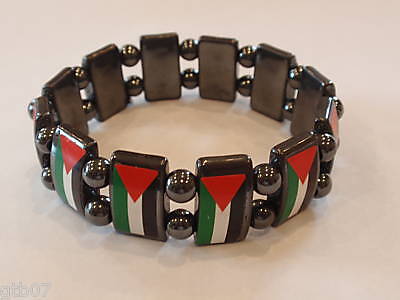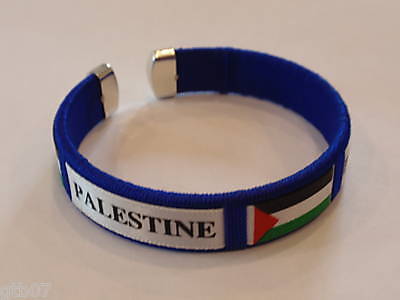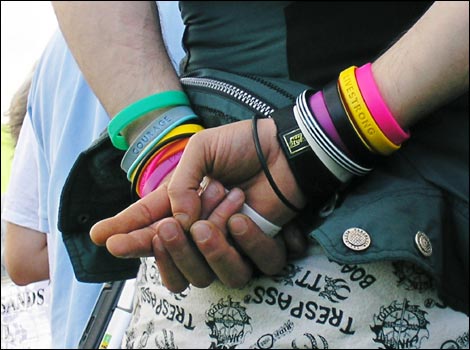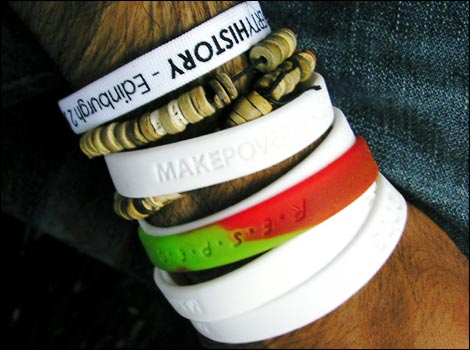Source(google.com.pk)
Free Palestine Wristbands Biography
Throughout Cambodia's long history, religion has been a major source of cultural inspiration. Over nearly two millennia, Cambodians have developed a unique Khmer belief from the syncreticism of indigenous animistic beliefs and the Indian religions of Buddhism and Hinduism. Indian culture and civilization, including its languages and arts reached mainland Southeast Asia around the 1st century AD. It is generally believed that seafaring merchants brought Indian customs and culture to ports along the Gulf of Thailand and the Pacific en route to trade with China. The Kingdom of Funan was most probably the first Khmer state to benefit from this influx of Indian ideasThe golden age of Cambodia was between the 9th and 14th century, during the Angkor period, during which it was a powerful and prosperous empire that flourished and dominated almost all of inland Southeast Asia. However, Angkor would eventually collapse after much in-fighting between royalty and constant warring with its increasingly powerful neighbors, notably Siam and Dai Viet. Many temples from this period however, like Bayon and Angkor Wat still remain today, scattered throughout Thailand, Cambodia, Laos, and Vietnam as a reminder of the grandeur of Khmer arts and culture. Cambodia's unparalleled achievements in art, architectures, music, and dance during this period have had a great influence on many neighboring kingdoms, namely Thailand and Laos. The effect of Angkorian culture can still be seen today in those countries, as they share many close characteristics with current-day Cambodia.
The Angkorian architects and sculptors created temples that mapped the cosmic world in stone. Khmer decorations drew inspiration from religion, and mythical creatures from Hinduism and Buddhism were carved on walls. Temples were built in accordance to the rule of ancient Khmer architecture that dictated that a basic temple layout include a central shrine, a courtyard, an enclosing wall, and a moat. Khmer motifs use many creatures from Buddhist and Hindu mythology, like the Royal Palace in Phnom Penh, use motifs such as the garuda, a mythical bird in Hinduism. The architecture of Cambodia developed in stages under the Khmer empire from the 9th to the 15th century, preserved in many buildings of the Angkor temple. The remains of secular architecture from this time are rare, as only religious buildings were made of stone. The architecture of the Angkor period used specific structural features and styles, which are one of the main methods used to date the temples, along with inscriptions.
In modern rural Cambodia, the nuclear family typically lives in a rectangular house that may vary in size from four by six meters to six by ten meters. It is constructed of a wooden frame with gabled thatch roof and walls of woven bamboo. Khmer houses are typically raised as much as three meters on stilts for protection from annual floods. Two ladders or wooden staircases provide access to the house. The steep thatch roof overhanging the house walls protects the interior from rain. Typically a house contains three rooms separated by partitions of woven bamboo. The front room serves as a living room used to receive visitors, the next room is the parents' bedroom, and the third is for unmarried daughters. Sons sleep anywhere they can find space. Family members and neighbors work together to build the house, and a house-raising ceremony is held upon its completion. The houses of poorer persons may contain only a single large room. Food is prepared in a separate kitchen located near the house but usually behind it. Toilet facilities consist of simple pits in the ground, located away from the house, that are covered up when filled. Any livestock is kept below the house. Chinese and Vietnamese houses in Cambodian towns and villages are typically built directly on the ground and have earthen, cement, or tile floors, depending upon the economic status of the owner. Urban housing and commercial buildings may be of brick, masonry, or wood.Cambodia is predominantly Buddhist with 90% of the population being Theravada Buddhist, 1% Christian and the majority of the remaining population follow Islam, atheism, or animism.
Buddhist nun at Angkor Wat, Siem Reap, Cambodia.
Buddhism has existed in Cambodia since at least the 5th century CE Theravada Buddhism has been the Cambodian state religion since the 13th century CE (excepting the Khmer Rouge period), and is currently estimated to be the faith of 90% of the population.[3]
Cambodian style buddhist temple. Buddhism is the official state religion in Cambodia.
Islam is the religion of a majority of the Cham (also called Khmer Islam) and Malay minorities in Cambodia. According to Po Dharma, there were 150,000 to 200,000 Muslims in Cambodia as late as 1975. Persecution under the Khmer Rouge eroded their numbers, however, and by the late 1980s they probably had not regained their former strength. All of the Cham Muslims are Sunnis of the Shafi'i school. Po Dharma divides the Muslim Cham in Cambodia into a traditionalist branch and an orthodox branch.
Christianity was introduced into Cambodia by Roman Catholic missionaries in 1660. However, it made little headway at first, particularly among Buddhists. In 1972 there were probably about 20,000 Christians in Cambodia, most of whom were Roman Catholics. According to Vatican statistics, in 1953, members of the Roman Catholic Church in Cambodia numbered 120,000, making it, at that time, the second largest religion in the country. In April 1970, just before repatriation, estimates indicate that about 50,000 Catholics were Vietnamese. Many of the Catholics remaining in Cambodia in 1972 were Europeans—chiefly French. American Protestant missionary activity increased in Cambodia, especially among some of the hill tribes and among the Cham, after the establishment of the Khmer Republic. The 1962 census, which reported 2,000 Protestants i
[edit]Ways of life
[edit]Birth and death rituals
The birth of a child is a happy event for the family. According to traditional beliefs, however, confinement and childbirth expose the family, and especially the mother and the child to harm from the spirit world. A woman who dies in childbirth—crosses the river (chhlong tonle) in Khmer is believed to become an evil spirit. In traditional Khmer society, a pregnant woman respects a number of food taboos and avoids certain situations. These traditions remain in practice in rural Cambodia, but they have become weakened in urban areas.[4]
Death is not viewed with the great outpouring of grief common to Western society; it is viewed as the end of one life and as the beginning of another life that one hopes will be better. Buddhist Khmer usually are cremated, and their ashes are deposited in a stupa in the temple compound. A corpse is washed, dressed, and placed in a coffin, which may be decorated with flowers and with a photograph of the deceased. White pennant-shaped flags, called "white crocodile flags," outside a house indicate that someone in that household has died. A funeral procession consisting of an achar, Buddhist monks, members of the family, and other mourners accompanies the coffin to the crematorium. The spouse and the children show mourning by shaving their heads and by wearing white clothing. Relics such as teeth or pieces of bone are prized by the survivors, and they are often worn on gold chains as amulets.[4] If the child is always ill, his or her parents can go and change the name of child
[edit]Childhood and adolescence
Main article: Childhood and adolescence in Cambodia
Cambodian girls on a bicycle
A Cambodian child may be nursed until two to four years of age. Up to the age of three or four, the child is given considerable physical affection and freedom. Children around five years of age also may be expected to help look after younger siblings. Children's games emphasize socialization or skill rather than winning and losing.[4]
Most children begin school when they are seven or eight. By the time they reach this age, they are familiar with the society's norms of politeness, obedience, and respect toward their elders and toward Buddhist monks. The father at this time begins his permanent retreat into a relatively remote, authoritarian role. By age ten, a girl is expected to help her mother in basic household tasks; a boy knows how to care for the family's livestock and can do farm work under the supervision of older males. Adolescent children usually play with members of the same sex. During his teens, a boy may become a temple servant and go on to serve a time as a novice monk, which is a great honor for the parents.[4]
In precommunist days, parents exerted complete authority over their children until the children were married, and the parents continued to maintain some control well into the marriage. Age difference is strictly recognized with polite vocabulary and special generational terms for "you"







-vQ~~60_35.JPG)

GnyQ~~60_35.JPG)
Free Palestine Wristbands Biography
Throughout Cambodia's long history, religion has been a major source of cultural inspiration. Over nearly two millennia, Cambodians have developed a unique Khmer belief from the syncreticism of indigenous animistic beliefs and the Indian religions of Buddhism and Hinduism. Indian culture and civilization, including its languages and arts reached mainland Southeast Asia around the 1st century AD. It is generally believed that seafaring merchants brought Indian customs and culture to ports along the Gulf of Thailand and the Pacific en route to trade with China. The Kingdom of Funan was most probably the first Khmer state to benefit from this influx of Indian ideasThe golden age of Cambodia was between the 9th and 14th century, during the Angkor period, during which it was a powerful and prosperous empire that flourished and dominated almost all of inland Southeast Asia. However, Angkor would eventually collapse after much in-fighting between royalty and constant warring with its increasingly powerful neighbors, notably Siam and Dai Viet. Many temples from this period however, like Bayon and Angkor Wat still remain today, scattered throughout Thailand, Cambodia, Laos, and Vietnam as a reminder of the grandeur of Khmer arts and culture. Cambodia's unparalleled achievements in art, architectures, music, and dance during this period have had a great influence on many neighboring kingdoms, namely Thailand and Laos. The effect of Angkorian culture can still be seen today in those countries, as they share many close characteristics with current-day Cambodia.
The Angkorian architects and sculptors created temples that mapped the cosmic world in stone. Khmer decorations drew inspiration from religion, and mythical creatures from Hinduism and Buddhism were carved on walls. Temples were built in accordance to the rule of ancient Khmer architecture that dictated that a basic temple layout include a central shrine, a courtyard, an enclosing wall, and a moat. Khmer motifs use many creatures from Buddhist and Hindu mythology, like the Royal Palace in Phnom Penh, use motifs such as the garuda, a mythical bird in Hinduism. The architecture of Cambodia developed in stages under the Khmer empire from the 9th to the 15th century, preserved in many buildings of the Angkor temple. The remains of secular architecture from this time are rare, as only religious buildings were made of stone. The architecture of the Angkor period used specific structural features and styles, which are one of the main methods used to date the temples, along with inscriptions.
In modern rural Cambodia, the nuclear family typically lives in a rectangular house that may vary in size from four by six meters to six by ten meters. It is constructed of a wooden frame with gabled thatch roof and walls of woven bamboo. Khmer houses are typically raised as much as three meters on stilts for protection from annual floods. Two ladders or wooden staircases provide access to the house. The steep thatch roof overhanging the house walls protects the interior from rain. Typically a house contains three rooms separated by partitions of woven bamboo. The front room serves as a living room used to receive visitors, the next room is the parents' bedroom, and the third is for unmarried daughters. Sons sleep anywhere they can find space. Family members and neighbors work together to build the house, and a house-raising ceremony is held upon its completion. The houses of poorer persons may contain only a single large room. Food is prepared in a separate kitchen located near the house but usually behind it. Toilet facilities consist of simple pits in the ground, located away from the house, that are covered up when filled. Any livestock is kept below the house. Chinese and Vietnamese houses in Cambodian towns and villages are typically built directly on the ground and have earthen, cement, or tile floors, depending upon the economic status of the owner. Urban housing and commercial buildings may be of brick, masonry, or wood.Cambodia is predominantly Buddhist with 90% of the population being Theravada Buddhist, 1% Christian and the majority of the remaining population follow Islam, atheism, or animism.
Buddhist nun at Angkor Wat, Siem Reap, Cambodia.
Buddhism has existed in Cambodia since at least the 5th century CE Theravada Buddhism has been the Cambodian state religion since the 13th century CE (excepting the Khmer Rouge period), and is currently estimated to be the faith of 90% of the population.[3]
Cambodian style buddhist temple. Buddhism is the official state religion in Cambodia.
Islam is the religion of a majority of the Cham (also called Khmer Islam) and Malay minorities in Cambodia. According to Po Dharma, there were 150,000 to 200,000 Muslims in Cambodia as late as 1975. Persecution under the Khmer Rouge eroded their numbers, however, and by the late 1980s they probably had not regained their former strength. All of the Cham Muslims are Sunnis of the Shafi'i school. Po Dharma divides the Muslim Cham in Cambodia into a traditionalist branch and an orthodox branch.
Christianity was introduced into Cambodia by Roman Catholic missionaries in 1660. However, it made little headway at first, particularly among Buddhists. In 1972 there were probably about 20,000 Christians in Cambodia, most of whom were Roman Catholics. According to Vatican statistics, in 1953, members of the Roman Catholic Church in Cambodia numbered 120,000, making it, at that time, the second largest religion in the country. In April 1970, just before repatriation, estimates indicate that about 50,000 Catholics were Vietnamese. Many of the Catholics remaining in Cambodia in 1972 were Europeans—chiefly French. American Protestant missionary activity increased in Cambodia, especially among some of the hill tribes and among the Cham, after the establishment of the Khmer Republic. The 1962 census, which reported 2,000 Protestants i
[edit]Ways of life
[edit]Birth and death rituals
The birth of a child is a happy event for the family. According to traditional beliefs, however, confinement and childbirth expose the family, and especially the mother and the child to harm from the spirit world. A woman who dies in childbirth—crosses the river (chhlong tonle) in Khmer is believed to become an evil spirit. In traditional Khmer society, a pregnant woman respects a number of food taboos and avoids certain situations. These traditions remain in practice in rural Cambodia, but they have become weakened in urban areas.[4]
Death is not viewed with the great outpouring of grief common to Western society; it is viewed as the end of one life and as the beginning of another life that one hopes will be better. Buddhist Khmer usually are cremated, and their ashes are deposited in a stupa in the temple compound. A corpse is washed, dressed, and placed in a coffin, which may be decorated with flowers and with a photograph of the deceased. White pennant-shaped flags, called "white crocodile flags," outside a house indicate that someone in that household has died. A funeral procession consisting of an achar, Buddhist monks, members of the family, and other mourners accompanies the coffin to the crematorium. The spouse and the children show mourning by shaving their heads and by wearing white clothing. Relics such as teeth or pieces of bone are prized by the survivors, and they are often worn on gold chains as amulets.[4] If the child is always ill, his or her parents can go and change the name of child
[edit]Childhood and adolescence
Main article: Childhood and adolescence in Cambodia
Cambodian girls on a bicycle
A Cambodian child may be nursed until two to four years of age. Up to the age of three or four, the child is given considerable physical affection and freedom. Children around five years of age also may be expected to help look after younger siblings. Children's games emphasize socialization or skill rather than winning and losing.[4]
Most children begin school when they are seven or eight. By the time they reach this age, they are familiar with the society's norms of politeness, obedience, and respect toward their elders and toward Buddhist monks. The father at this time begins his permanent retreat into a relatively remote, authoritarian role. By age ten, a girl is expected to help her mother in basic household tasks; a boy knows how to care for the family's livestock and can do farm work under the supervision of older males. Adolescent children usually play with members of the same sex. During his teens, a boy may become a temple servant and go on to serve a time as a novice monk, which is a great honor for the parents.[4]
In precommunist days, parents exerted complete authority over their children until the children were married, and the parents continued to maintain some control well into the marriage. Age difference is strictly recognized with polite vocabulary and special generational terms for "you"
Free Palestine Wristbands
Free Palestine Wristbands
Free Palestine Wristbands
Free Palestine Wristbands

Free Palestine Wristbands
Free Palestine Wristbands

Free Palestine Wristbands

Free Palestine Wristbands
Free Palestine Wristbands

Free Palestine Wristbands
Free Palestine Wristbands
No comments:
Post a Comment